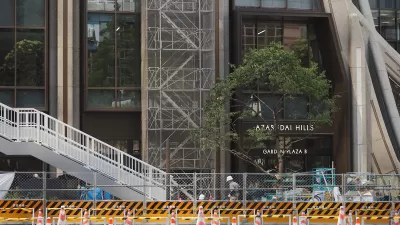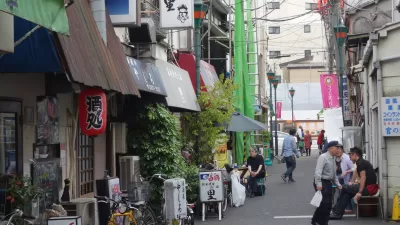The new exhibit at Toyko's Mori Art Museum will be the first architecture showcase since the 2011 earthquake, and displays a movement central to the country's history of building and rebuilding.
The Metabolism movement began in the 1960s around a group of architects focused on creating structures that emulate organic life and allow for continual growth and change. "Sustainability and scale were paramount and they channeled these values not through a lens of austerity but of sci-fi dreams," explains reporter Kevin McGarry.
Examples of their work, such as the subcompact dwellings within the Nakagin Capsule Tower, built in 1971 by Kisho Kurukowa operate dually as a design oddity and manifestation of utopian planning theories hatched more than a decade earlier in the face of over population and limited space.
The exhibit is distilled into a slideshow by McGarry, who concludes that although "many of these buildings may recall a nostalgic vision of the future, projects influenced by Metabolism are still sprouting up in oceans, deserts and cultural centers the world over, and its driving ethos is as timely as it is timeless."
FULL STORY: Out There: Metabolic Pathways

Planetizen Federal Action Tracker
A weekly monitor of how Trump’s orders and actions are impacting planners and planning in America.

Restaurant Patios Were a Pandemic Win — Why Were They so Hard to Keep?
Social distancing requirements and changes in travel patterns prompted cities to pilot new uses for street and sidewalk space. Then it got complicated.

Map: Where Senate Republicans Want to Sell Your Public Lands
For public land advocates, the Senate Republicans’ proposal to sell millions of acres of public land in the West is “the biggest fight of their careers.”

Maui's Vacation Rental Debate Turns Ugly
Verbal attacks, misinformation campaigns and fistfights plague a high-stakes debate to convert thousands of vacation rentals into long-term housing.

San Francisco Suspends Traffic Calming Amidst Record Deaths
Citing “a challenging fiscal landscape,” the city will cease the program on the heels of 42 traffic deaths, including 24 pedestrians.

California Homeless Arrests, Citations Spike After Ruling
An investigation reveals that anti-homeless actions increased up to 500% after Grants Pass v. Johnson — even in cities claiming no policy change.
Urban Design for Planners 1: Software Tools
This six-course series explores essential urban design concepts using open source software and equips planners with the tools they need to participate fully in the urban design process.
Planning for Universal Design
Learn the tools for implementing Universal Design in planning regulations.
Heyer Gruel & Associates PA
JM Goldson LLC
Custer County Colorado
City of Camden Redevelopment Agency
City of Astoria
Transportation Research & Education Center (TREC) at Portland State University
Camden Redevelopment Agency
City of Claremont
Municipality of Princeton (NJ)





























